History of Asai Sensei
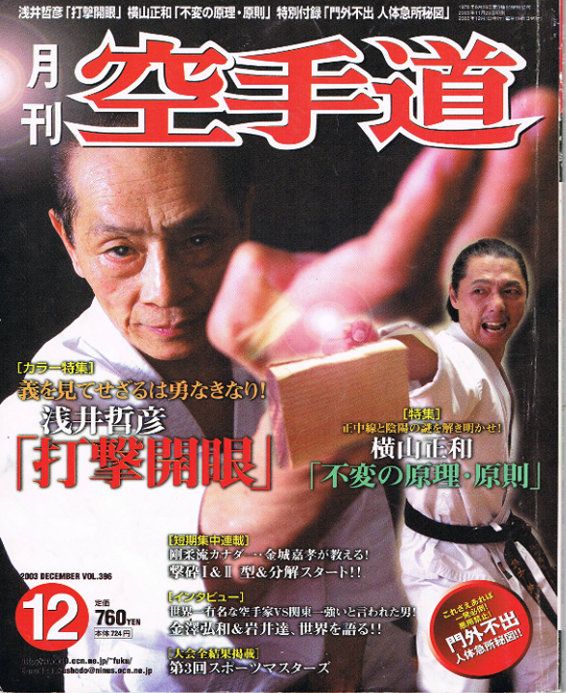
月刊空手道 2003 12月号より 翻訳者 大竹アリサ
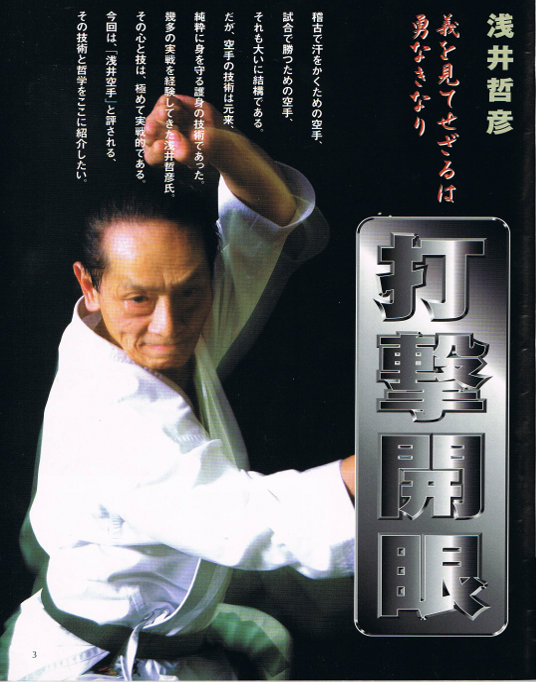
You can have whatever reason to do karate - to work out in practices, to win in a match…
However, karate techniques were originally skills just for self-defense.
Mr. Tetsuhiko Asai who has done numerous actual fights - his soul and techniques are extremely practical.
This time, we would like to introduce some of the techniques and philosophy of the Asai Karate.
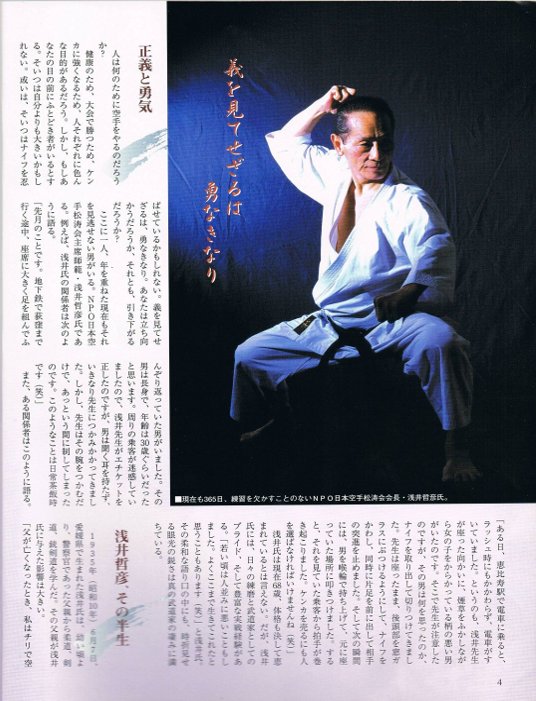
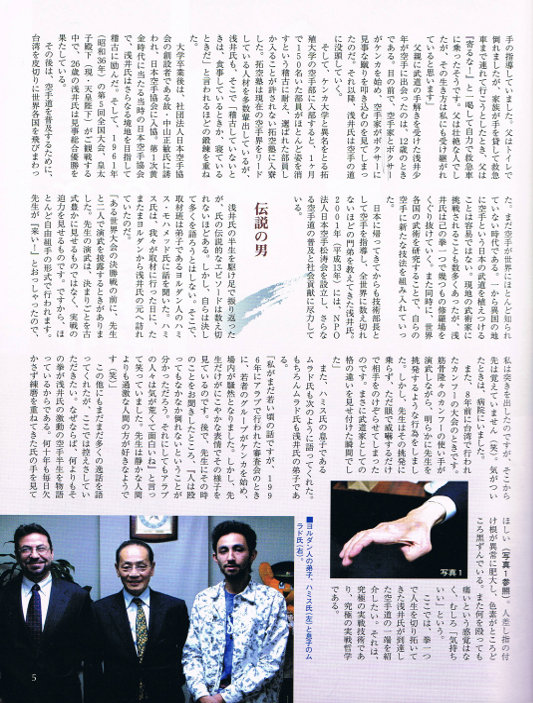
・Justice and Courage
Why do karate?
There are many reasons that people decide to do karate - for their health, to win a competition, to be strong enough to defeat in a fight…
Suppose there is a bad guy standing right in front of you.
He might be bigger than you.
Or he might be hiding a knife.
"Courage is doing what is right."
Would you stand up against him or not?
There's this one, who cannot overlook injustice in spite of his age.
He's Mr. Tetsuhiko Asai, the Principal Grand Master of NPO Japan Karate Shotokai.
One of his officials says,
"It was a month ago.
There was a guy on the seat of the subway train for Ogikubo, leaning back with his legs crossed, taking a lot of space. He was tall, and looked like 30ish.
Some people around him looked disgusted by his behavior, so Mr. Asai tried to convince him not to do that. He wouldn't listen to him, and suddenly made a snatch at Mr. Asai.
However, Mr. Asai easily got control of him just by snatching the guy's arm.
This kind of thing happens like every day. lol" Another official of him says,
"One day, I got on a train at Ebisu, when the train was not crowded although it was a rush hour.
Mr. Asai sat on a seat, and found a vulgar fellow on the other side of the train. He was smoking, and playing a joke on a girl. That was the reason for the emptiness of the train.
Mr. Asai gave caution to the fellow, but he took a knife out, and tried to hack at Mr. Asai.
Mr. Asai ducked his knife without standing up. He just moved his head backwards to the window, and at the same time, he stopped the guy's next step by sticking out one of his legs toward that guy.
In another second, he grabbed him by the neck, and slammed him down back on his seat.
Then, people around burst into applause.
You need to be careful when you pick a fight with someone. lol"
Mr. Asai, now being 68 years old, doesn't really have the ideal masculine body.
He, however, has practiced every day, which made him proud of being a martial artist. Also he has done a reasonable number of actual fights.
"I did some bad things just like other people when I was young.
I sometimes even think how I could survive, lol"
says Mr. Asai.
Despite his dovelike tone of voice, the keenness of his eyes he shows at times is filled with his self-confidence as the true martial artist.
"
・Tetsuhiko Asai, Half His Lifetime
Mr. Asai was born in Ehime Prefecture on June 7, 1935. He started learning judo, kendo and jukendo.
His father had a great influence on him.
"When my father passed away, I was conducting karate training in Chile.
He fell sick in the bathroom, and when the family members gave him a hand to take him to the ambulance, he turned their offer down, saying, "Go away!" Then, he stepped forward to get on the ambulance by himself.
He spent a checkered life, and the way he spent his life also influenced mine, I think.
Mr. Asai as a little boy was learning some basic stuff of martial arts from his father until he met karate when he was 12.
That's when he saw a fight between a karate artist and a boxer. The karate artist simply defeated the boxer with a strong kick.
Ever since, he has been devoting himself to karate.
He then joined Karate Club at Takushoku University with the nickname of Fighting University. The practice there was so hard that most of the 150 original members left the club within the first month. The rest of the original members who bore throughout the practice joined Takkujuku.
Takkujuku has been developing a number of human resources that are currently leading the karate world. Mr. Asai describes his hard practice as, "I am always practicing except for when I am eating or sleeping."
After graduation, he joined Japan Karate Association (JKA) as the founder of JKA, the late Mr. Masatoshi Nakayama, asked him for participation.
At that time, JKA was on the first Golden Age, and Mr. Asai practiced more hardly ever.
At the 5th National Karate Competition in 1961, while Crown Prince (present Emperor) was watching, 26-year-old Mr. Asai proudly won the first place.
After that, he flew all over the world, starting in Taiwan, to spread karate.
It was the time when karate was barely known in the rest of world.
It was not easy to introduce a Japanese martial art, karate, in other countries with different backgrounds.
Local martial artists often offer challenges to him, but Mr. Asai went over numerous adversities with his fist.
Also, simultaneously, doing some research on local martial arts gave him a chance to add some new techniques into his karate.
Even after his return, he has been teaching karate as the technical director, and now has countless disciples all over the world.
He founded NPO Japan Karate Shotokai in 2001, and is exerting himself to popularize karate and to make a social contribution.
・Man of Legend
There're still countless legendary episodes of him after we looked back half of his life.
However, he himself is not the person who would talk a lot of himself.
Therefore, we asked one of his disciples, Mr. Hamis Muhammad from Jordan, about Mr. Asai.
He was there visiting Mr. Asai. It was an opportunity provided by chance.
"Once Mr. Asai and I performed right before the final round at a world match.
Mr. Asai's performance always shows the vital spark of actual fights. It's not something to show some kind of old arrangements in an old style. That's why his performances are almost always done in a free style.
As he said, "Come on!," I made a lunge at him, but I don't remember what happened after that. lol I was at the hospital when I became conscious.
A kung-fu match in Taiwan 8 years ago is another story.
This brawny kung-fu player gave an act of provocation to Mr. Asai while his performance.
Mr. Asai just declared his dare, and turned his intimidating gaze on the guy, which simply beat him up.
That was the moment to define the level difference between them as martial artists."
Mr. Murad, the son of Mr. Hamis told us the following story.
Of course he is also a disciple of Mr. Asai.
"When I was still young, at a board of review in Arab in 1996, a group of young people started fighting, which made the audience turbulent.
Mr. Asai was the only one who was looking, with a smile on his face, at what was happening there.
Later, I asked him about the happening. 'Now you know it is not easy to beat someone up.
By the way, Arabian people seem to have a furious temper. It's interesting, huh?'
he said smiling.
It appears to me that he likes furious-minded people better than quiet ones. lol"
He told us lots of other side stories, but we just leave them.
For Mr. Asai's fist says it all. Nothing else could speak better about his checkered karate life.
Take a look at his hand. This is the hand after several decades of everyday practice. (see Photo 1)
The base of his index finger is abnormally corpulent. You can also see some pigmentation.
He no longer feels any pains from hitting things, no matter what they are. He just "feels good."
Now, we would like to show one end of the karate life of Mr. Asai, who worked his life out with his fist.
That is the ultimate techniques in actual fights and also the ultimate philosophy of actual fights.
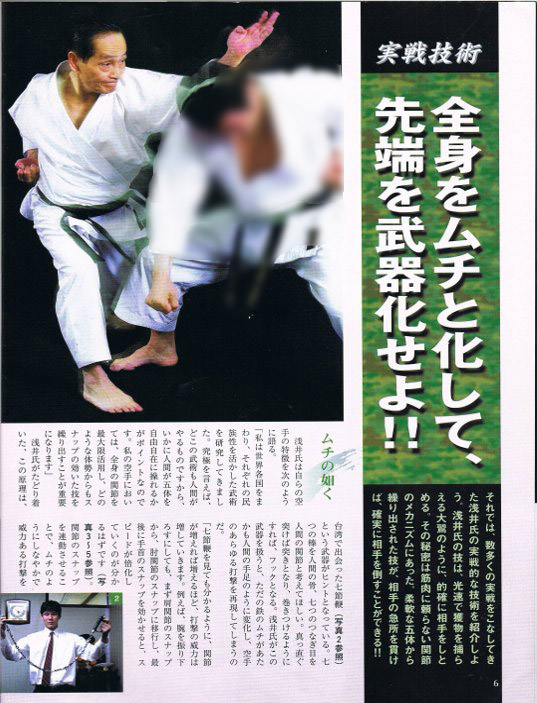
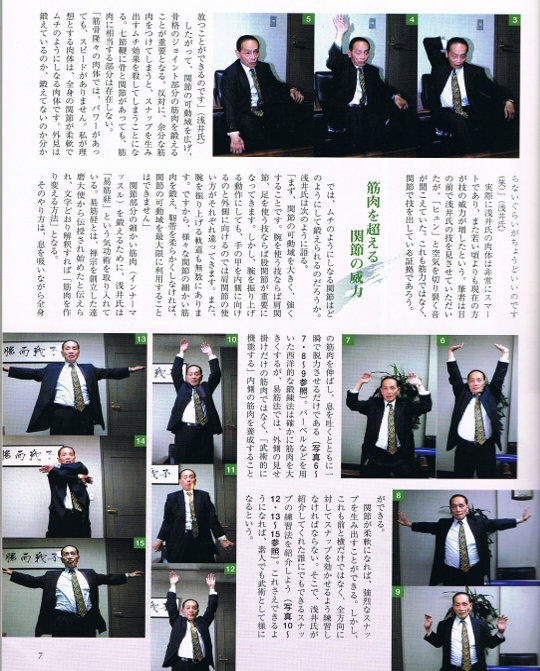
Actual Fight Techniques Turn your body into a whip and weaponize its edge!!
Let us introduce some of Mr. Asai's actual fight techniques. His techniques can accurately bring the opponent down like a great egret catching a prey in a speed of light. The mechanism of his joints that does not rely on his muscles made it possible. Techniques your flexible body creates can easily beat your opponent!!
・Like A Whip
Mr. Asai describes his karate as follows.
"I've been to different parts of the world, and studied martial arts that take advantage of their ethnicities.
The point is how flexibly you can control your own body because martial art is something done by human beings no matter where.
To talk about my own karate, I would make use of all of my joints to turn out techniques with snap that can be done from any kinds of positions. That's something important."
He got an inspiration from a weapon called seven-jointed whip he saw in Taiwan, and finally reached this principle.
Imagine that the seven sticks as bones, and the seven joints as joints.
Lunging straight makes a lunge, while wrapping it around the body makes a hook.
Mr. Asai can express different kinds of karate strokes with the whip. It's only an iron whip, but it does act like human's arms and legs.
"As you can see from the seven-jointed whip, more joints it has, more power one single stroke can bring.
For instance, when you bang your arm down, you first need to make a snap at your shoulder joint, and move it to the elbow joint, and then finally, make a snap at your wrist. That way, you can feel the speed increase. (see Photo 3-5)
Gearing joint snaps enables you to make a strong and flexible stroke like a whip." (Mr. Asai)
Therefore, it's important to build up your muscle around the joints as well as to broaden the range of joint motion.
On the other hand, putting more muscle than needed decrease the whip effect that creates snaps.
Although seven-jointed whips have bones and joints, they don't have anything like muscle.
"Brawny bodies may have power, but have no speed.
To me, the ideal body shape is the one with flexible joints that creeps like a whip.
It doesn't have look obviously trained. lol" (Mr. Asai)
Sure enough, Mr. Asai is really slender. He also says the power of his strokes increased when compared to the past.
I saw him doing his karate up close, and I certainly heard the zing sound he made with his arm.
This also proves that he creates his strokes with his joints, not with his muscle strength.
・Joint Power Exceeds Muscle
How were his whip-like flexible joints built up?
Mr. Asai says,
"First, you need to broaden the range of joint motion as well as to strengthen the joints.
For techniques that use arms, shoulder joints are important, and hip joints for those that use legs.
However, even when you bring your arm up, the way you use your shoulder joints differ according to the direction the back of your hand goes to.
Also, there're countless paths to bring your arm up.
So, you cannot make use of the range of joint motion until you build up meticulous muscle around different joints, and stretch your ligament."
To work the inner muscle out, Mr. Asai uses a kind of Qigong arts called "Ekisetsukei."
Ekisetsukei was reportedly initiated by Daruma-Taishi who founded the Zen sect, and literally means "How to rebuild muscle."
That's really easy. You just stretch your overall systemic muscle, and relax as you exhale. (see Photo 6-9)
Western training using weights can build your muscle up, but Ekisetsukei can develop inner muscle that functions martial artistically.
Flexible joints can create strong snaps.
However, you need to practice so that you can snap toward every direction, not only forward and backward.
Now, we would like to introduce some of his easy snap exercises. (see Photo 10-12, 13-15)
If you can make it, that would make you look a real martial artist.
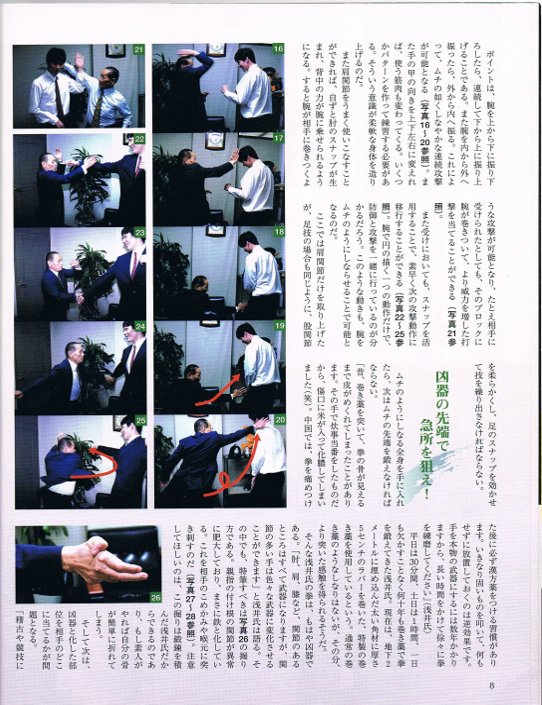
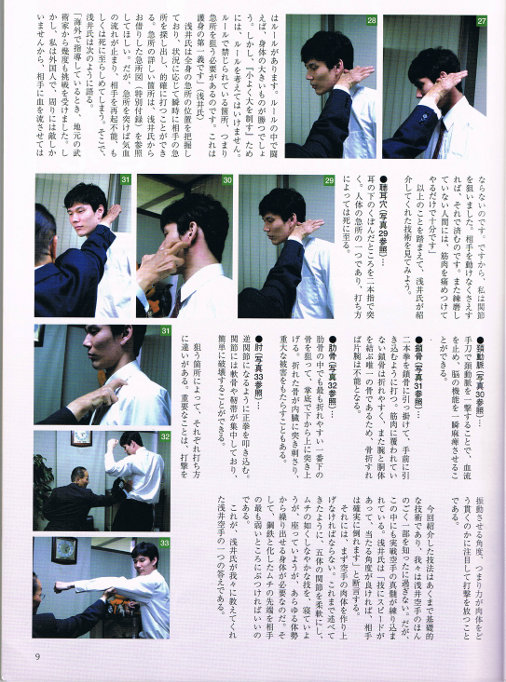
The point is that after you bring your arm down, you need to bring it up instantly.
Also, when you move it outward, immediately move it inward.
This enables you to make consecutive attacks like a whip. (see Photo 16-20)
To build up different muscle of your arm, turn your hand around so that the back of your hand faces different directions.
You will need to create some patterns to practice.
Keep this in mind. You will be able to build up a flexible body.
Another thing is that being able to use your shoulder joints automatically makes elbow joints, and you will bring the strength in your back to your arms.
Then, you will be able to attack with your arms that go around your opponent. Even if your opponent blocks your attack, your arm is still surrounding his/her blocking arm; therefore you can make more efficient attack.
Also in blocking, snaps can help you to move on to next attack motion quickly. (see Photo 22-25)
You can see that a single arm motion that draws a circle can do both defending and offending.
This kind of motion is also become possible by making your arms like whips.
We talked only about shoulder joints here, but these tips also apply to the legs. Make them flexible to create strokes using your leg snaps.
・Aim at the vital spot with the edge of your weapon!
Now, after building your body up like a whip, you have to work on the edge of the whip.
"A long time ago, I used to hit a makiwara, a rolled straw punching pad, until the skin ripped to show the bone of my hand.
It was when I was on the cook's duty. Some rice grains got into the wound, and that suppurated it. lol
In China, it is a common practice to put some Chinese ointment on your wounded fist.
If you are not fully skilled yet, I don't recommend you to leave it after punching something hard.
It will take several years to weaponize your hands, so take time to brush them up gradually." (Mr. Asai)
He spent several decades to work his fists up with the makiwara, practicing every day - 30 minutes a day on weekdays, and 1 hour a day on weekends.
At the moment, he is using a special punching pad. It is a thick square timber rolled with 5-centimeter thick rubber, and it is buried in the ground of the depth of 2 meters.
It's not as flexible as a normal makiwara, but you can easily get a feel of punch.
Mr. Asai's fists have already been weaponized.
"Any parts that have joints like elbows, shoulders and knees can be weaponized, and especially any parts with more joints would work as different kinds of weapons," Mr. Asai says.
Pay close attention to his clasped hand in Photo 26.
The root joint of his thumb is abnormally swollen, and is like iron.
This part of his thumb pokes the opponent's temple or throat.
What you need to remember is that this can be only done by someone who has trained for ages like him, and if this were done by an amateur, they would break their bones.
Now, we need to know where to hit with your weaponized fist.
"Practice and match have some rules.
If you fight within the rules, the one who is physically bigger will probably win.
You can beat anyone who is bigger than you if you strictly follow the rules.
To beat him, it's necessary to attack his vital point.
This is the very first principle of self-defense," Mr. Asai says.
He has a good knowledge of vital points all over the body, and this enables him to know quickly where he should attack, and also to hit the point accurately.
The detailed vital point location can be found in the map that comes with this magazine.
However, you must keep this in mind that attacking any vital points will your opponent's blood flow stop, which gives him a great damage or even bring him to death.
Mr, Asai says,
"When I was giving lessons in other countries, local martial artists came to me and offered a challenge to me.
I am, however, a foreigner, and everyone else around me was an enemy, so I didn't of course want to give my opponent a fatal damage.
I instead attacked his joint.
All I wanted to do was to make him unable to make an attack.
Also, for those who have not trained a lot, hurting their muscle is just enough."
Keep what he mentioned in mind, and let's look at the following techniques Mr. Asai introduced.
Kyosha (the vital point under the ears, see Photo 29)
Hit the point with two fingers.
It's one of the human's vital points, and hitting it can result in the opponent's death.
Carotid Artery (see Photo 30)
Make a strike at the carotid artery with your knife hand stops your opponent's blood flow, which temporarily paralyzes the brain function.
Clavicle (see Photo 31)
Hang two fingers on the Clavicle and pull it forward.
The clavicle that is not covered with muscle is easy to be broken. It is also the only bone that connects your body and arm, so breaking it means you will no longer be able to use your arm for the rest of the match.
Ribs (see Photo 32)
Aim to strike the most frangible rib at the most bottom, and knock it up with the bottom of your fist (outside the little finger).
If a bone fracture happens, the broken bone can penetrate some internal organs, which might cause a fatal damage.
Elbows (see Photo 33)
Hit the elbow with a righteous fist so that the elbow joint can be reversed.
Joints are where cartilage and ligament gather, and they are extremely frangible too.
It is important to remember that you need to make a difference depending on where to hit.
Another thing you might want to keep in mind is to know how the power you will create affects the opponent before you actually make the strike.
These techniques introduced here are basic skills, and it is just like we got to know only a small part of the Asai Karate.
However, you can still find some essential stuff of practical karate here.
Mr. Asai says positively, "You can beat your opponent if you can make enough speed in your technique and hit it in the right angle.
To do so, you first have to build up your body.
As I have been telling you, you also need to make all your joints flexible in order to create strikes as flexible as a whip no matter if you're asleep or sitting, and that should be also possible from any kind of positions.
The other thing you need to do is hit the end of your steel-like whip to the opponent's weakest point.
This is the only answer Mr. Asai told us about his karate.
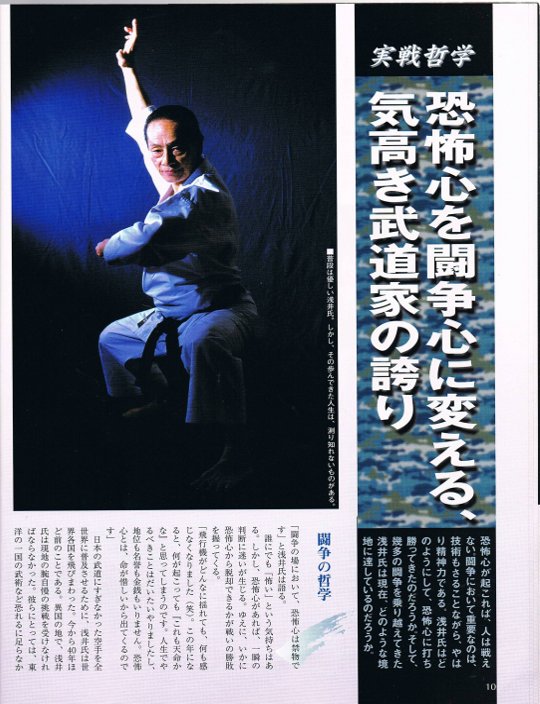
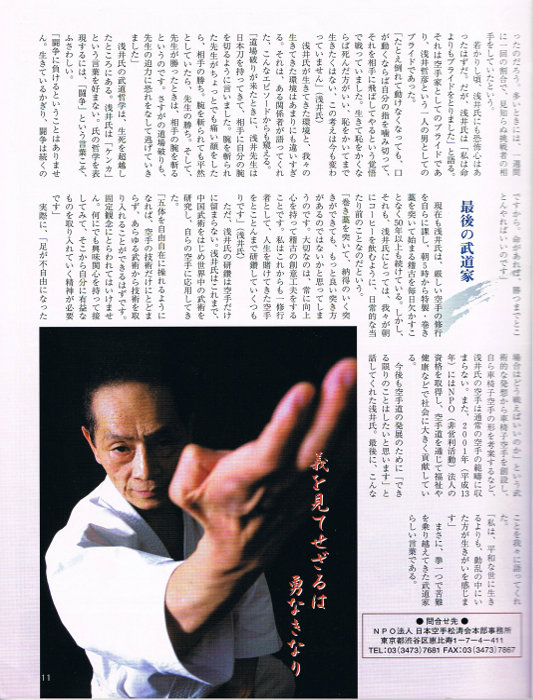
・Practical Philosophy
The pride of the noble martial artist who changes his fear to fighting spirit
When fear happens, you can't fight.
What is important when fighting is not only techniques but spiritual strength.
How has Mr. Asai come over his fear?
And what kind of feelings does he have after having had numerous fights.
Fighting Philosophy
"Having fear is not accepted at a fight," Mr. Asai says.
Everyone has a feeling of "fear,"
but if that occurs when fighting, that means you may not be able to make a right decision when needed.
Therefore, how you can get out of the fear would be the key to success.
"I no longer have fear even when my plane gets really bumpy. lol
I am old enough to be calm no matter what happens, and to think, "This should be Heaven's will."
I have done what I needed to, and I don't need any status, glory or money.
Fear happens when you don't want to lose your life."
Karate used to be only a martial art in Japan. Mr. Asai flied all around the world to spread it to every part of the world.
It was 40 years ago.
He had to respond to a local fighter's challenge in a foreign country.
To them, local fighters, karate must have been something they didn't need to be scared of as it was only a martial art of this small country in East Asia.
Fighting with a local challenger sometimes happened once a week.
Mr. Asai should have had some kind of fear when he was young,
yet he says, "My pride was more important than my life to me."
It was his pride as a martial artist, and also his pride as a man, Tetsuhiko Asai.
"When fighting, I was always prepared for anything, say, if it became impossible to make more moves, I would still have used my mouth to bite one of my fingers away of my hand to throw it to the opponent.
I thought being embarrassed was worse than death, and this is still my idea even now." (Mr. Asai)
The environment Mr. Asai was raised in is way too different from ours.
That can be also seen from this episode an official of his told us.
"When a challenger came to Mr. Asai, he brought a Japanese sword and told the challenger to make a cut on Mr. Asai's arm.
The challenger wins if Mr. Asai's face grimaces from pain,
but if that doesn't happen, Mr. Asai wins.
And that's also when he can cut the opponent's arm out.
To hear this, the challenger got scared and ran away."
Mr. Asai's martial arts philosophy is beyond the subject of life and death.
He doesn't like to use the word "kenka" to mean fight.
The most suitable word to express his philosophy is "tousou" which also means fight in Japanese.
"I am never beaten down because fighting continues as long as you are alive.
You can put all your effort until you really win a fight."
・The Last Martial Artist
Mr. Asai still makes it a task to have a hard practice that starts at 5 in the morning with hitting a self-made rolled straw punching pad. He's been doing that for more than 50 years.
He says that is something like we do every day, like having a coffee in the morning.
"Even when I make a satisfactory hit at the rolled straw punching pad, I will always think there should be a better way to hit it.
It is important to always have ambition and to make the best use of inventiveness in practice.
I am going to grind myself in karate as a practitioner." (Mr. Asai)
Karate is not the only thing he has been dedicating his life for.
He has tried every kind of martial arts in the world, including Chinese martial arts, to enhance his own karate style.
"Being able to control your body flexibly means you can merge different skills from any martial arts, not only from karate.
You need to have a flexible brain to conceive new ideas.
Also, you need to be interested in all kinds of things, and sort out what's advantageous and what's not for you," he says.
He once thought how he could fight if he crippled his legs, and that martial-artistic idea helped him to think up wheelchair karate katas - Mr. Asai's karate cannot be categorized in general karate, it's beyond that.
His Karate Shotokai became a nonprofit organization in 2001, and he is contributing in such fields as welfare and health through karate.
He says, "I very much would like to do anything I can do," even hereafter, for the development of karate-do.
At the very end of the interview, he told us this:
"I find my life worth living when I'm in a storm center rather than when in a peaceful atmosphere."
It's something only he can say - the martial artist who has overcome lots of martyrdom with one fist.
